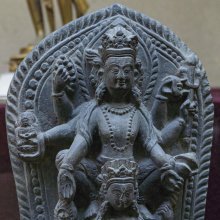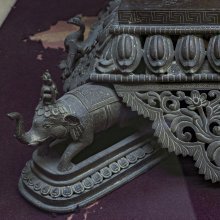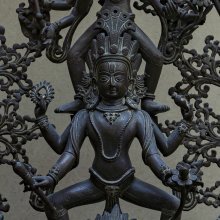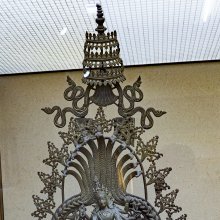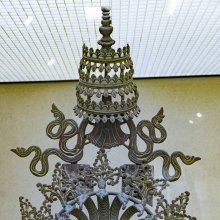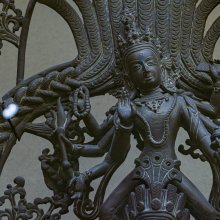Harihariharivahana, Harihariharivāhana, Hariharihari-vahana: 1 definition
Introduction:
Harihariharivahana means something in Buddhism, Pali. If you want to know the exact meaning, history, etymology or English translation of this term then check out the descriptions on this page. Add your comment or reference to a book if you want to contribute to this summary article.
Images (photo gallery)
(+4 more images available)
In Buddhism
Tibetan Buddhism (Vajrayana or tantric Buddhism)
Source: archive.org: The Indian Buddhist Iconography1) Harihariharivāhana (हरिहरिहरिवाहन) or Harihariharivāhanalokeśvara refers to one of the various forms of Avalokiteśvara having their Sādhana described in the 5th-century Sādhanamālā (a collection of sādhana texts that contain detailed instructions for rituals).—His Colour is white; his Vāhana is Siṃha, Garuḍa and Viṣṇu; He has six arms.—The composition of the deity is so queer that great difficulty is experienced in recognizing the images of this form of Avalokiteśvara, called by the peculiar name of Harihariharivāhana. The Sādhana gives a description of the god, but is practically silent as to why such a special name is given to this particular variety of Lokeśvara.
The Dhyāna (meditation instructions) of Harihariharivāhana is described in the Sādhanamālā as follows:
“The worshipper should think himself as the Harihariharivāhana form of god Avalokiteśvara, white in all limbs, with the Jaṭāmukuṭa (crown of matted hair) and clad in graceful garments. He cites the Tathāgata as witness with one of his right hands, carries the rosary in the second, and instructs deluded people with the third. He carries the staff inone of his left hands, the deer-skin in the second and the Kamaṇḍalu in the third. He sits on the shoulder of Viṣṇu below whom there are Garuḍa and the lion. Thus meditating...”
[In the drawing of Hariharharivāhana illustrated in the Appendix there is a snake below the lion. The snake also has the synonym of “Hari” in Sanskrit, and that is how a snake is added, although it is not required by the Sādhana.
2) Harihariharivāhana (हरिहरिहरिवाहन) or Harihariharivāhanalokeśvara refers to number 4 of the 108 forms of Avalokiteśvara found in the Machhandar Vahal (Kathmanu, Nepal). [Machhandar or Machandar is another name for for Matsyendra.].
Accordingly,—
“Regarding Harihariharivāhana: lowermost is the snake, on it is the lion, over the lion is Garuḍa, Nārāyaṇa rides Garuḍa, and on his shoulder sits Lokeśvara. The Garuḍa has two hands in the Añjali mudrā. Nārāyaṇa has four hands, of which the first pair is engaged in forming the Añjali against the chest; while the second pair has the Cakra in the right hand and the Gadā in the left. Lokeśvara sits in Vajraparyaṅka and has six arms ; the right hands show the rosary, the Cakra and the Varada pose, while the three left carry the Tridaṇḍī, the noose and the Utpala”.
The names of the 108 deities [viz., Harihariharivāhana] possbily originate from a Tantra included in the Kagyur which is named “the 108 names of Avalokiteshvara”, however it is not yet certain that this is the source for the Nepali descriptions. Tibetan Buddhism includes schools such as Nyingma, Kadampa, Kagyu and Gelug. Their primary canon of literature is divided in two broad categories: The Kangyur, which consists of Buddha’s words, and the Tengyur, which includes commentaries from various sources. Esotericism and tantra techniques (vajrayāna) are collected indepently.
See also (Relevant definitions)
Partial matches: Vahana.
Starts with: Harihariharivahanalokeshvara, Harihariharivahanasadhana.
Full-text: Harihariharivahanalokeshvara.
Relevant text
Search found 2 books and stories containing Harihariharivahana, Harihariharivāhana, Hariharihari-vahana, Hariharihari-vāhana; (plurals include: Harihariharivahanas, Harihariharivāhanas, vahanas, vāhanas). You can also click to the full overview containing English textual excerpts. Below are direct links for the most relevant articles:
The Indian Buddhist Iconography (by Benoytosh Bhattachacharyya)
108 forms of Avalokiteśvara (4): Harihariharivāhana Lokeśvara
Stupas in Orissa (Study) (by Meenakshi Chauley)
